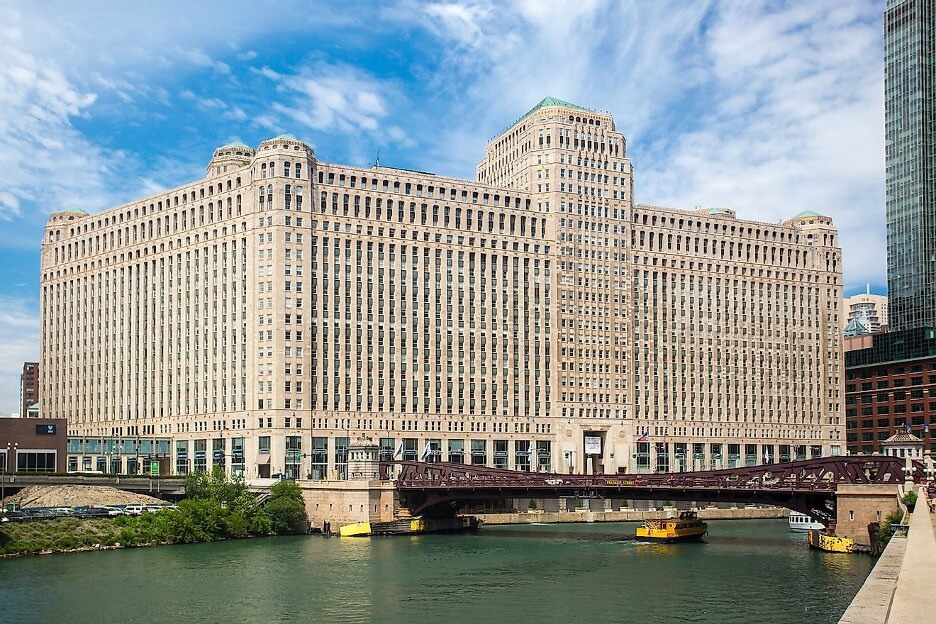Calling All Architecture Lovers – 10 Amazing Facts About Chicago Buildings
June 20, 2022
We are getting ourselves ready to attend the AIA Convention and Expo are in Chicago this week and there could not be a better location than the Windy City. Chicago is an incredible playground for those of us that love architecture. In preparation and celebration of this week of architecture, we are sharing this wonderful article to help you get ready and enjoy one of our favorite cities.
10 Amazing Facts About Chicago Buildings
- Many groundbreaking architects in the late 19th and early 20th centuries, used the city of Chicago as a canvas to showcase some of their best structural masterpieces.
- The Tribune Tower features fragments taken from 150 attractions around the world including the Great Wall of China, the Berlin Wall, and the Great Pyramid of Egypt.
- The exterior of the Carbide and Carbon Building has real 24-karat gold embellishments.
The city looks like an architect’s playground canvas replete with structural masterpieces in every shape and form. These stunning structures built by America’s most famous architects make Chicago one of the world’s most awe-inspiring architecture cities. The intricate details in each building, the beautiful fusion of materials, and the bold use of quirky shapes in different sizes in these megastructures lend to the city’s aesthetic appeal. Chicago is indeed a giant design museum, showcasing the best of American architecture and structural ingenuity.
If you are an architecture lover who’s always been fascinated by Chicago’s structural icons, here are some facts you may have not known about them.
10. The Exterior of The Carbide and Carbon Building Has Real 24-Karat Gold Embellishments

Carbide and Carbon building in Chicago. Image credit: 4kclips/Shutterstock.com
This dazzling skyscraper along Michigan Avenue was built in 1920 for the Union Carbide and Carbon Corporation. Designed by Daniel and Hubert Burnham, the children of famous Chicago architect and urban planner Daniel H. Burnham, the building features Art Deco luxury and opulence. It uses beautiful black granite at the base, green and gold terracotta for the tower, and real 24-karat gold leaf embellishments at the top. It’s the first building to use colors other than the usual gray and white.
And this structure’s extravagance extends indoors, the lobby features black Belgian marble with gold and bronze trimmings. Now known as the St. Jane Hotel, the building is a testament to the exuberance, opulence, and luxury of Art Deco designs of the 20s.
9. The Willis Tower Held the Title of World’s Tallest Building For 25 Years.

The Willis Tower standing out as the tallest building in the Chicago skyline. Image credit: Songquan Deng/Shutterstock.com
Formerly known as the Sears Building, this towering structure of black aluminum and tinted glass, took three years to build. Finished in 1974, the design is said to have been inspired by a pack of cigarettes. With its 110 floors shooting straight up from the grounds of Chicago, it held the title of the world’s tallest building for 25 years until it was surpassed by New York’s World Trade Center. It’s one of the most iconic buildings in Chicago’s skyline.
8. The Tribune Tower Has Fragments Taken From 150 Famous Architectural Wonders from All Over the World

Tribune Tower, Chicago. Image credit: Danielo/Shutterstock.com
One of the world’s most beautiful buildings, this neo-Gothic piece of architectural wonder features soaring towers, tall buttresses, and gargoyles reminiscent of Medieval Europe. Built from 1923 to 1925, this Gothic-revival building was designed by New York architects John Mead Howells and Raymond Hood.
Its most notable feature however can be found on the ground floor. Embedded around the façade are fragments from 150 famous sites all over the world including stones from the cave of the nativity, the great pyramid of Egypt, the Berlin Wall, the Great Wall of China, and the White House among many others.
7. The Wrigley Building Uses Six Different Shades of White Terracotta

The Wrigley Building in Chicago. Image credit: Tinnaporn Sathapornnanont/Shutterstock.com
Gleaming on what seems to be an oddly shaped lot located west of Michigan Avenue and just north of the river, the Wrigley building was designed by architecture firm Graham, Anderson, Probst & White. It’s owner, chewing gum magnate, William Wrigley Jr., wanted to recreate the gleaming night light displays of the 1893 Columbian Exposition so he made use of six different shades of white terracotta for the building’s exterior. The shade gets brighter and lighter from bottom to top and so it looks gleaming when the façade is illuminated at night.
6. The Swirling Waves of The Aqua Building Reduces Wind Pressure

The Aqua Tower was completed in 2010. Image credit: Shutterstock.com
One of the newest additions to the Chicago skyline, this quirky building although made with the same metal, concrete, and glass materials like others around it, feature unique concrete balconies that look like rippling fabric wrapped around the structure. From afar, the structure that’s designed by Jeanne Gang looks like it’s surrounded by white waves undulating with the wind.
But these balconies weren’t just built for aesthetic purposes. The shape and curves help break up the pressure and force of the wind (Chicago is called the windy city for a reason). They also shade neighboring apartments thereby preventing birds from colliding with the glass windows.
5. The Marina Bay Towers Were Designed to Be a City Within a City

Famous Marina City Towers like corn cob beside Chicago River in downtown of Chicago, Illinois. Image credit: BorisVetshev/Shutterstock.com
Completed In 1967 and designed by architect Bertrand Goldberg, this structure is famous in Chicago for the two towers that many say resemble giant corn cobs. Goldberg, who believed no right angles exist in nature and so none should exist in architecture, compared the curved balconies to petals of a sunflower.
The buildings were designed to be a city within a city to attract dwellers back to the metropolis during the Chicago urban exodus. The goal was to bring back middle-class Chicagoans who had moved away from the city by attracting them with a mixed-use development that has everything they need within walking distance to their workplace.
4. The Rookery Building Light Court Features Designs by Root and Wright

Central stair of the Rookery Building in Cook County, Chicago, USA.
Originally designed by Daniel Burnham and John Root in 1888, the Rookery was then redesigned by Frank Lloyd Wright in 1905 during which white marble with gold embellishments was added to the interior, planters were introduced to bring in natural elements like plants, and pillars were painted white to brighten up the outdated space. Its most famous feature is the magnificent light court with high glass ceilings that bring in natural light and an intricately designed oriel staircase.
3. The Merchandise Mart Was Once the Largest Building in The World

The Merchandise Mart on a clear winter morning. Image credit: FiledIMAGE/Shutterstock.com
Now known as The Mart, this art-deco structure was designed and built by Alfred P. Shaw and the Chicago architectural firm of Graham, Anderson, Probst & White from 1928 to 1930. With 4,000,000 square feet (372,000 m 2) of floor space, it’s still considered one of the world’s biggest commercial buildings in terms of area coverage.
It sits along the Chicago River and spans two city blocks. It’s one of the city’s most iconic structures that serve as a business hub for many companies in Chicago.
2. The Sullivan Center Features a Dramatic Main Entrance Clad with Cast Iron Ornaments Designed By Louis Sullivan

Sullivan Center, Chicago. Image credit: Conchi Martinez/Shutterstock.com
Formerly known as the Carson, Pirie, Scott & Co. building it is a commercial structure designed by Louis Sullivan in 1889 and was one of the last buildings designed by the famous architect. It’s a magnificent structure at the corner of State and Madison. It features white terracotta exteriors with large windows and a distinct main entrance that’s designed to attract the attention of people walking along both streets. The entire bottom floor is clad in green cast iron with intricate patterns. It’s famous for its dramatic iron-clad main entrance located right at the corner of the two busy avenues.
1. The Chicago Cultural Center Is Home to Two Beautiful Stained Glass Domes

Chicago Cultural Center. Image credit: Saurabh13/Shutterstock.com
Completed in 1897, the Chicago Cultural Center was built by the country’s best architects. Boston architects Shepley, Rutan & Coolidge used the most exquisite materials they could find like rare imported marble, mosaics of Favrile glass that was inspired by Venetian landmarks, and mother-of-pearl among others to showcase Chicago’s rise as a stylish metropolis.
Inside what used to be the city’s first public library, are two massively beautiful glass domes. One of which is the Tiffany dome, the world’s largest Tiffany glass dome in existence. It measures 38 feet in diameter and is made with 30,000 pieces of glass.
The Author
Loraine Balita-Centeno is a Toronto-based writer, editor, and digital media manager who’s been working for magazines, newspapers, and media sites for 15 years. Her work has been published in magazines like Cosmopolitan Magazine, Smart Parenting, Good Housekeeping, Dubai-based Illustrado Magazine, and Canadian news media site The Post Millennial among others.





